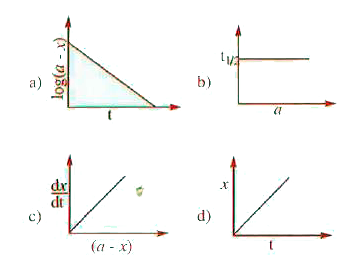Which of the following graphs represent a first order reaction (a=initial concentration of reactant, x=concentration of reactant consumed, t=time)
 Solution in Telugu
Solution in Telugu
a,b,d
c,d
b,c
a,b
The correct Answer is:C
Step by step video, text & image solution for Which of the following graphs represent a first order reaction (a=initial concentration of reactant, x=concentration of reactant consumed, t=time) by Chemistry experts to help you in doubts & scoring excellent marks in Class 12 exams.
Updated on:21/07/2023Topper's Solved these Questions
- CHEMICAL KINETICSBOOK - AAKASH SERIESCHAPTER - CHEMICAL KINETICSEXERCISE - Objective Exercise - 3 (Previous NEET/AIPMT Questions)
32 Videos
- CHEMICAL KINETICSBOOK - AAKASH SERIESCHAPTER - CHEMICAL KINETICSEXERCISE - Objective Exercise - 4 (Assertion (A) & Reason (R) Type Questions)
44 Videos
- CHEMICAL KINETICSBOOK - AAKASH SERIESCHAPTER - CHEMICAL KINETICSEXERCISE - Objective Exercise - 1
124 Videos
- CHEMICAL KINETCSBOOK - AAKASH SERIESCHAPTER - CHEMICAL KINETCSEXERCISE - EXERCISE - 3.2
45 Videos
- CHEMICAL THERMODYNAMICSBOOK - AAKASH SERIESCHAPTER - CHEMICAL THERMODYNAMICSEXERCISE - Additional Practice Exercise
54 Videos
Similar Questions
For a first order reaction A→B the reaction rate at reactant concetration of 0.01 M is found to be 2.0×10−5mol L−1s−1. The half life period of the reactionis
View Solution(A) Spontaneous reaction may be slow or fast.
(R ) Spontaneous nature deals with feasibility of the reaction but not rate.
View SolutionWhich of the following reactions occurs at measurable rate?
View SolutionDiscuss on the kinetic spontaneity of a chemical reaction. Is a slow reaction spontaneous? Why?
View SolutionWhich among the following is not an exact differential?
View SolutionIn a zero-order reaction, if the initial concentration of the reactant is doubled, the time required for half the reactant to be consumed
View SolutionThe half life of a first order reaction is 30 min and the initial concentration of the reactant is 0.1 M . If the initial concentration of reactant is doubled ,then the half life of the reaction will be
View SolutionWhich of the followin ng fraphs represent a first order reaction (a= initial concentration of reactant, x= concentration of reactant consumed, t = time) ?
View SolutionWhat will be the nature of the graph showing the concentration of the reactant and time of a first order reaction ?
View SolutionThe initial concentration of the reactant in a first order reaction is a . It takes time t for the completion of noth fraction of the reaction. Will it take time 2t for the completion of the same fraction if the initial concentration of the reactant is made twice ?
View SolutionHow does the initial concentration of the reactant in a first order reaction very with time ?
View SolutionShow that the time of a first order reaction takes for 'the nth' fraction of the initial concentration of its reactant to converted into product does not depend on the initial concentration of the reactant.
View SolutionFor a zero order reaction, the initial concentration of the reactant =[A]0 and after time 't' from the initiation of the reaction, the concentration =[A] . What will be the nature of the graph of '[A]' vs 't,
View SolutionPlot a graph of concentration of a reactant at time t, [ (a-x)] against time for a first order reaction .Here a = initial concentration of the reactant an x = change in concentration of the reactant at any time 1 during the reaction.
View SolutionFor a first order reaction, the concentration of reactant :
View Solution
